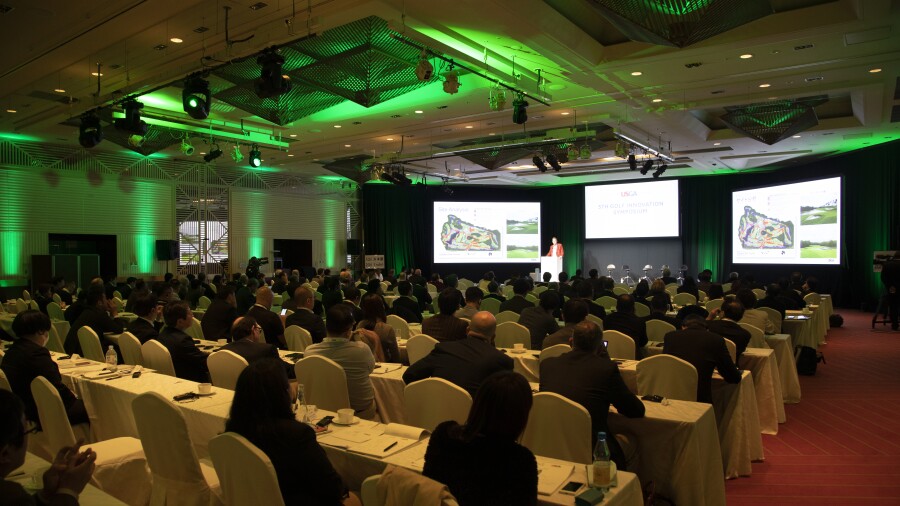MELBOURNE, Fla. — When it comes to keeping up with the group ahead, golfers at Crane Creek Reserve Golf Course in Melbourne, Fla. don’t have a problem. That’s because they have respect for the kind but firm words of starter Sally White, who seems to rule the roost at this in-town municipal facility that’s exceedingly popular with the locals.
It helps that this par-71 layout, designed by Donald Ross in 1926 – with a routing plan in the architect’s telltale style hidden away in a clubhouse annex – is only 5,886 yards from the back tees and 5,344 from the more commonly used middle tees. At 4,656 yards from the forward tees it’s also not a stretch for players with slower swing speeds.
About 40 percent of the folks here walk, many of them using a pull cart. Yet even with seven ponds and a large culvert down the middle the pace of play is a brisk 3:30 to 4 hours. The green-to-tee connections are proximate and it’s just about impossible to lose a golf ball in the rough. So golfers don’t spend a lot of time looking for wayward shots. It’s either wet or it’s easily found in play.
All of which suits Sally the Starter just fine. “There’s no need for a big speech at the first tee,” says White. “And if someone calls in from the course and complains about the group ahead of them, I’ll head out there and casually ask them how it’s going, how are you doing, and engage them in a simple conversation.”
It helps her demeanor as a ranger that White previously invested 34 years as an elementary school physical education teacher. Spend enough time with kids K-6 and you become an effective communicator in soft, nonthreatening language – exactly what’s needed when you have the tender task of approaching sluggish golfers and entreating them to play faster.
“I might say something about the group behind them having called in,” adds White. "And that we’d appreciate it if they catch up with the group ahead.”

USGA eyes slow play solutions for daily-fee facilities
Industry-wide, golf struggles with slow play and how to expedite golfers. In an era of declining participation – golf lost 1.9 million participants from 2011 to 2017 – 7 percent of its consumer base - the industry is taking a close look at how to encourage golfer satisfaction. Private management firms and consultants have been trying for years to reverse the trend. Now they are being joined by the USGA, which has coordinated an effort to address the problem.
The initiative began a decade ago when the USGA teamed up with a manufacturing industry consultant out of Pebble Beach, California, named Bill Yates, who became an unofficial pace of play guru. Yates, who passed away a year ago, helped the USGA reduce round times at national championships by reformulating everything from tee time separation to the location of spectator crossings. The staff at Golf House in Far Hills, N.J. broadened its approach by studying thousands of rounds played by everyday golfers. It amounted to an expanded version of time and motion studies that had been a staple of the manufacturing sector, this time helped by GPS monitoring devices that tracked every step a golfer took and mapped it out collectively.
The next step was consumer satisfaction surveys, which revealed that the two most important items on how players experience a round are course conditioning and pace of play.
It might seem strange for a game based upon timeless tradition and the absence of a play clock to indulge in data gathering. But as Bodo Sieber, CEO and co-founder of the golf course pace of play management firm Tagmarshal, said in a recent webinar, a “customer journey analysis” is crucial to understanding how golfers experience a round in general and slow play in particular. He was summarizing what underlay presentations at the Fifth Golf Innovation Symposium in Tokyo, undertaken in conjunction with the USGA and the Japan Golf Association. The idea follows what Sieber paraphrased as the gospel of pioneering business analyst Peter Drucker: “What gets measured gets managed. If you can’t measure it, you can’t improve it.”
The work could not come at a better time. Slow play has been gnawing away at the PGA Tour and the LPGA for over a decade. And just last week, the European Tour’s Edoardo Molinari was so concerned with what he said were rounds lasting 5:30 that he tweeted out previously undisclosed data documenting slow times for Continental players.
As promised...list of timings as of April 22nd. Next updates list will come out at the end of June!
— Edoardo Molinari (@DodoMolinari) April 27, 2019
There are a few usual suspects and a few surprises.
Please retweet and share to speed things up!#stopslowplay pic.twitter.com/VpR65M4Xrb
Simply urging golfers to play faster does not suffice if the “flow-through” structure of the golf course presents nearly insurmountable obstacles like a profusion of hazards and heavy rough on the right side of holes, where most (right-handed golfers) hit the ball. Architects and management companies have now become more attuned to the need to reduce such hindrance factors – without compromising design integrity.
Perhaps the biggest single move, known as “Tee it forward,” is to get golfers to play the course length appropriate to their swing speed rather than to their ego. In many cases, that has meant 16-handicpapers playing from 6,200 yards rather than 6,600 yards, and setting forward tees at around 4,500 yards rather than at 5,400 yards.
A concern for expediting the flow of a round was also one of the motivating factors behind recent rules changes that reduced the time allowed for looking for lost golf balls, and that gave players more options to drop from the immediate area in the case of a lost ball or out of-bounds without reverting to one of the biggest time killers of all, stroke and distance penalties.
Studies also showed that pace of play could be accelerated if tee times were stretched out a bit, from the 7-8 minutes found at many daily-fee courses to 10 minutes.
The accelerated pace of play, it is hoped, will more than compensate for the marginal reduction in tee times per hour, leading to happier golfers who feel like the round was worth it and who will therefore be encouraged to return to the facility for more golf.
In other words, use increased pace of play as a marketing asset.
In all of this, using starters and rangers as bullies to push people about faster is actually the worst possible approach. In fact, it’s so bad it’s counterproductive. USGA studies revealed that among the most discouraging elements of a golf round are aggressive rangers. The game is tough enough without the added frustration of being harassed to play faster.
All of which Sally White seems to know, intuitively if not necessarily through careful study of industry data. A softer approach goes a long way in public golf. It’s not an approach that is enough on the professional tours, where the consensus is that the best response to slowpokes would be penalty strokes, not just fines. But in a consumer setting the dynamics are different. Especially at a facility like Crane Creek Reserve, where the design lends itself to relatively trouble-free passage and players just need a reminder.





















Yeah.. had an, umm, "interesting" yet somewhat frustrating experience recently on a course using BOTH rangers and Tag Marshall -- our foursome was stuck behind a quite slow moving group, yet despite at least three or four visits from the ranger .. who also saw fit to converse with us each time he drove back from that group?!? .. and warnings from the Tag Marshall unit affixed to each cart .. they kept at it....
Naturally we had a group breathing down our necks but on this course you cannot see "ahead" to the next hole.
So the slow group bails after 9 and guess what?
On our #11 the group behind us complains to the ranger .. who drives up to us and tells us to 'stop talking and play faster'...!!??!!
So how do you fix that problem?
one of the biggest problems is that the average golfer plays a hole in about 12 minutes, with tee times at 9 minute intervals, it is all but impossible not to have a slow down or stack up somewhere along the course. tee times should be no less than 10 minutes apart
Played some golf in Az this spring. Keeping the flag stick in really seemed to help keep things moving:
1. Players on green more likely to putt up rather than waiting for someone off the green to play.
2. Less time wasted putting in and taking out flagstick
3. Using rangefinder from fairway easier and quicker because flag is always in the hole.
It took a little while to get used to pin being in the hole while putting but over time it is feeling more normal. Only real distraction was on short putts where flag shadow was over ball.
I would suggest that it was saving us around 15 minutes per round versus times from previous year.
Lots of retirees out there who could be used as part-time marshals. One marshal for every 6 holes, using firm but polite influence to keep the pace flowing. With the correct spacing in tee times, and proper on-course guidance, pace can be improved. There are MANY design traits that have either positive or negative influences on pace of play. When you have a long distance from one green to the next tee, a group who is walking will be caught by a group that is riding (something I've seen at the Links at Lighthouse Sound), or having a Par 3 as your second hole is like slamming on the brakes before you ever get up to speed. Cart Path Only is a pace killer, ALWAYS.
I play a public course, (3 courses)
tourist area for buddy packages 🤑
Biggest problem, (Golfer Pride), playing wrong tees.
Remove blue tees completely from course will help tourist golfers to move up to whites and get off the whites.
Marshall’s Inform players 6 putts creates slow play and is not aloud.
Post in cart, LARGE PRINT, tees are based on handicap!!
If you don’t know your handicap, play forward tees🤣🤣
Sorry, I meant move up to green tees
Did you also mean "Allowed", instead of, "Aloud"?
Weekend play tends to be slow but courses could make weekend pin placements easier. Most weekend golfers aren't looking for big challenges just fun!
If Cary paths were at the same elevation as tee boxes older and handicapped golfer’s wouldn’t have to struggle up to the tee. It you have to put in stairs to tee box something is wrong.
Time spent on greens can be shortened by putting through...when player away puts...he continues putting through hole...no re-marking, no respotting..relifting and recleaning....put through to finish.
saves time...try it...you will come to enjoy it after a few holes.
1. As most club golf is social the giving of putts up to 12 inches should be encouraged.
A fourball marking and putting short putts 'a la tv' puts at least 15 minutes on any round.
2. Gazing through range finders before every fairway/approach shot is definitely 10 minutes added to a person's round. Totally unnecessary when playing at one's own club where there are 150 yard markers and different coloured flags for front, middle and rear pin placements.
The "Giving of putts" totally disqualifies you from having a legitimate handicap. Any score posted as such is not a true score
Pace of play has noticeably improved here in Australia at least since the abolition of the rule penalising a player for hitting the flagstick while putting. When that rule was introduced in the 1970s I thought it was silly and that all it would do would be to slow play. I was right. This year we are getting around 18 holes in about 15-25 minutes per round than last year.